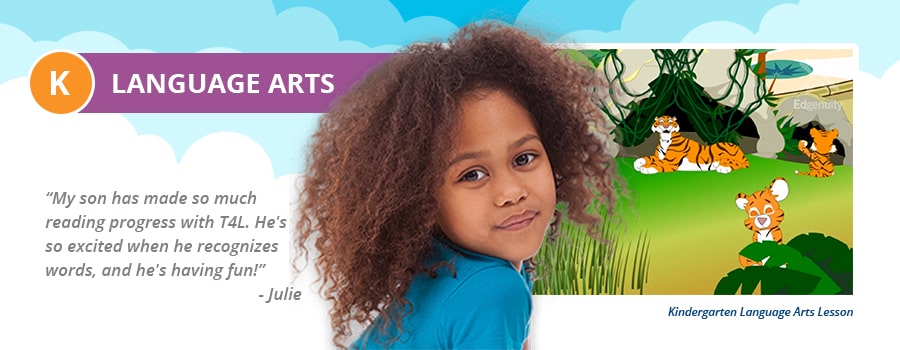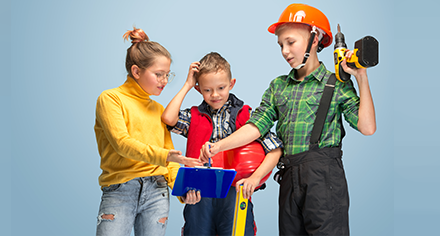Kindergarten Language Arts Curriculum and Lesson Plans
Phonics, reading and writing should all be components of a kindergarten language arts curriculum. These areas are crucial in helping a child build important literacy and communication skills. It all begins with gaining a thorough understanding of each letter of the alphabet. From there, students will be able to put letters together in order to begin reading and writing.
This page provides information on the language arts concepts a kindergarten student should know, objectives in reading and writing, as well as an overview of the Time4Learning kindergarten language arts curriculum and how it can help your child build a strong language arts foundation.
Language Arts Concepts for Kindergarteners
There are a number of kindergarten language arts concepts that a student should know. Being familiar with the alphabet and the sounds of each letter will help students gain an understanding of basic phonics skills, which will set the stage for learning to read and write.
Having phonological awareness will help students distinguish one letter sound from another. From there, phonemic awareness comes into play. This helps students recognize and differentiate initial sounds, and also create new words by replacing one letter with another.
Students in kindergarten should also have good listening skills. This will help them begin to build their vocabulary and comprehension skills even before they start reading.
Kindergarten Reading Goals/Objectives
This year, students will begin to learn to read. The reading goals of the Time4Learning language arts activities for kindergarten aim to give students a thorough understanding of the sounds each letter makes and understand the subtle difference in word meanings. Students will discover new vocabulary words, develop fluency, and reading comprehension skills. They will engage in reading activities, and are expected to answer basic questions about stories, nursery rhymes, and more.
Below are some of the reading goals/objectives for kindergarten.
- Demonstrate understanding of all letters of the alphabet and their sounds
- Demonstrate comprehension by recalling details
- Demonstrate comprehension by matching pictures with sentences
- Recognize and read sight words
- Show familiarity with rhyming and beginning sounds
Kindergarten Writing Goals/Objectives
This year, students will take part in prewriting and writing activities that will give them the necessary skills to begin writing words, sentences, and stories. In addition to receiving instruction, students will also take part in supported practice activities. Students will learn the basics of writing an opinion, writing to give information, and more.
Below are some of the writing goals/objectives for kindergarten.
- Write an opinion through a combination of drawing, dictating, and writing
- Recall information from an experience and write about it using details
- Write a story with sentences to explain an event
Time4Learning’s Kindergarten Language Arts Lesson Plan
Through a series of pre-reading, reading, and comprehension activities that incorporate discovery learning and direct teaching, the student will explore the alphabet, the parts of a book, and the fundamental concepts of print. The student will also demonstrate understanding of the parts of a book and the basic concepts of print.
Through a series of exploratory and assessment activities, the student will demonstrate knowledge of the alphabet and will identify the numbers of words in a sentence and the number of letters in a word.
Through a series of pre-reading, reading, and comprehension activities that incorporate discovery learning and direct teaching, the student will explore concepts of rhyme, pattern, and the five senses. The student will also demonstrate comprehension by completing patterns of text and by associating the five senses with their functions.
Through a series of exploratory and assessment activities, the student will demonstrate knowledge of rhyme and syllables.
Through a series of pre-reading, reading, and comprehension activities that incorporate discovery learning and direct teaching, the student will learn new vocabulary, develop fluency, and learn a reading strategy. The student will also demonstrate comprehension by recalling details and identifying colors..
Through a series of phonological awareness, phonics, reading, and prewriting activities that incorporate discovery, recognition, and application, the student will demonstrate understanding of the letters “m” and “s” and their sounds.
Through a series of pre-reading, reading, and comprehension activities that incorporate discovery learning and direct teaching, the student will learn new vocabulary, develop fluency, and learn a reading strategy. The student will also demonstrate comprehension by distinguishing between fantasy and reality and by associating the familiar words over and under with their meanings.
Through a series of phonological awareness, phonics, reading, and prewriting activities that incorporate discovery, recognition, and application, the student will demonstrate understanding of the letter “d” and its sound and the letter “a” and its short sound.
Through a series of pre-reading, reading, and comprehension activities that incorporate discovery learning and direct teaching, the student will learn new vocabulary, develop fluency, and develop reading comprehension skills. The student will demonstrate comprehension by completing sentences and by associating familiar opposite words with their meanings.
Through a series of phonemic awareness, phonological awareness, phonics, reading, and prewriting activities that incorporate discovery, recognition, and application, the student will demonstrate understanding of the letter “p” and its sound and the letter “i” and its short sound.
Through a series of pre-reading, reading, and comprehension activities that incorporate discovery learning and direct teaching, the student will learn new vocabulary, develop fluency, and develop reading comprehension skills. The student will demonstrate comprehension by sequencing events from a story and by associating concepts of taller and shorter with their meanings.
Through a series of phonemic awareness, phonological awareness, phonics, reading, and prewriting activities that incorporate discovery, recognition, and application, the student will demonstrate understanding of the letters “l” and “n” and their sounds.
The student will learn thematic content through discovery and achieve comprehension by reading literature with emphasis on vocabulary. Stories use controlled vocabulary to enhance phonemic awareness.
Through a series of phonics activities that incorporate recognition and application, the student will demonstrate understanding of the letters “m”, “d”, “s”, “p”, “l”, “n” and their sounds and the letters “a” and “i” and their short sounds. Select Type Learning Paths Description.
Through a series of connected activities that incorporate discovery learning and direct teaching, the student will learn new vocabulary, develop fluency, and develop reading comprehension skills. The student will gain a deep understanding of the words “practice” and “cool”, learn about nuances in word meaning, and demonstrate comprehension by answering questions about reading for a purpose and by discriminating patterns.
Through a series of phonemic awareness, phonics, reading, and prewriting activities that incorporate discovery, recognition, and application, the student will demonstrate understanding of the letters “t” and “h” and their sounds.
Through a series of pre-reading, reading, and comprehension activities that incorporate discovery learning and direct teaching, the student will develop fluency and reading comprehension skills. The student will demonstrate comprehension by matching pictures with sentences and by associating familiar words “in” and “out” with their meanings.
Through a series of phonemic awareness, phonics, reading, and prewriting activities that incorporate discovery, recognition, and application, the student will demonstrate understanding of the letter “o” and its short sound and the letter “b” and its sound.
Through a series of pre-reading, reading, and comprehension activities that incorporate discovery learning and direct teaching, the student will develop fluency and reading comprehension skills. The student will demonstrate comprehension by recalling details and matching pictures with the correct verb tense.
Through a series of phonological awareness, phonemic awareness, phonics, reading, and prewriting activities that incorporate discovery, recognition, and application, the student will demonstrate understanding of the letter “e” and its short sound and the letter “r” and its sound.
Through a series of connected activities that incorporate discovery learning and direct teaching, the student will develop fluency and reading comprehension skills. The student will gain an understanding of nuances in word meaning and demonstrate comprehension by matching pictures with sentences and by grouping objects according to their function.
Through a series of phonemic awareness, phonics, reading, and prewriting activities that incorporate discovery, recognition, and application, the student will demonstrate understanding of the letters “k” and “f” and their sounds.
Through a series of phonemic awareness activities that incorporate recognition and application, the student will demonstrate understanding of the sounds of the letters “t”, “h”, “f”, “r”, “k”, “b”, “d” and the short sounds of the letters “o”, “a”, “e”, and “i”.
Through a series of phonics activities that incorporate recognition and application, the student will demonstrate understanding of the letters “t”, “h”, “f”, “r”, “k”, “b”, “d” and their sounds and the letters “o”, “a”, “e”, “i” and their short sounds.
Through a series of connected activities that incorporate discovery learning and direct teaching, the student will develop fluency and reading comprehension skills. The student will gain a deep understanding of the word “help”, learn about nuances in word meaning, and demonstrate comprehension by recalling details and identifying the picture that corresponds to the correct noun form.
Through a series of phonemic awareness, phonics, reading, and prewriting activities that incorporate discovery, recognition, and application, the student will demonstrate understanding of the letter “g” and its hard sound and the letter “u” and its short sound.
Through a series of connected activities that incorporate discovery learning and direct teaching, the student will learn new vocabulary, develop fluency, and develop reading comprehension skills. The student will gain a deep understanding of the word “ingredients”, the multiple meanings of “change”, and learn about nuances in word meaning. In addition, the student will demonstrate comprehension by sequencing events from a story and by associating familiar words (before, after) with their meanings.
Through a series of phonemic awareness, phonics, reading, and prewriting activities that incorporate discovery, recognition, and application, the student will demonstrate understanding of the letter “c” and its hard sound and the letter “w” and its sound.
Through a series of pre-reading, reading, and comprehension activities that incorporate discovery learning and direct teaching, the student will learn new vocabulary, develop fluency, and learn a reading strategy. The student will also demonstrate comprehension by distinguishing between fantasy and reality and by identifying and sorting common words into basic categories (colors, shapes, foods).
Through a series of phonological awareness, phonemic awareness, phonics, reading, and prewriting activities that incorporate discovery, recognition, and application, the student will demonstrate understanding of the letter “y” and its consonant sound and the letter combination “qu-” and its sound.
Through a series of pre-reading, reading, and comprehension activities that incorporate discovery learning and direct teaching, the student will develop fluency and reading comprehension skills. The student will demonstrate comprehension by drawing conclusions and identifying common synonyms.
Through a series of phonemic awareness, phonics, reading, and prewriting activities that incorporate discovery, recognition, and application, the student will demonstrate understanding of the letters “v” and “x” and their sounds.
Chapter Test: Seasons – ILA
Through a series of pre-reading, reading, and comprehension activities that incorporate discovery learning and direct teaching, the student will learn new vocabulary, develop fluency, and develop reading comprehension skills. The student will demonstrate comprehension by sequencing events from a story and identifying nouns.
Through a series of phonemic awareness, phonics, reading, and prewriting activities that incorporate discovery, recognition, and application, the student will demonstrate understanding of the letters “z” and “j” and their sounds.
The student will learn thematic content through discovery and achieve comprehension by reading literature with emphasis on vocabulary. Stories use controlled vocabulary to enhance phonemic awareness.
Through a series of phonics activities that incorporate recognition and application, the student will demonstrate understanding of the letters “c”, “z”, “v”, “w”, “j”, “g”, “x”, “y” and their sounds, the letter combination “qu-” and its sound, and the letters “i”, “a”, “u”, “o” and their short sounds.
Listen for and repeat middle and last sounds in one-syllable words.
Learn to create new, real words by adding sounds to a word.
Identify vowels and vowel sounds in words.
Through a series of learning activities focused on discovery, recognition, and application, the student will practice phonetic skills. Student will experience words in a variety of modes, including rhyme and story.
Distinguish between similarly spelled words by identifying the sounds of the letters that differ.
Read a story and retell was read. Learn to explain why they read the story.
Identify characters, settings, and major events in a story.
Ask and answer questions about unknown words in a text.
Identify the role of an author and illustrator in a story.
Learn how the words and pictures work together to tell a story.
Identify characters in a story and compare and contrast the characters’ experiences.
Ask questions and find answers in a text.
Identify the topic and details of a text.
Make connections in a nonfiction text.
Ask and answer questions about unknown words in a text about animals.
Identify and use the information on the front cover, back cover, and title page of a book to know what the book is about.
Name the author and illustrator of a nonfiction book and understand the role of each in presenting information.
Describe how illustrations are linked to details in a text.
Identify supporting reasons in a text.
Read two nonfiction books and tell how they are alike and different.
Write an opinion through a combination of drawing, dictating, and writing.
Write an informative text in which first sentence tells topic, next sentences give facts.
Write a story with sentences to explain the event and the writer’s feelings about the event.
Make writing better by asking someone to help you and then make changes to your writing.
Use information from what they read plus recall information they already know to write about a topic.
Recall information from an experience and write about it using details.
Scope & Sequence Copyright © 2024 Edgenuity, Inc. All rights reserved.
Why Choose Time4Learning?
The Time4Learning kindergarten language arts curriculum is a comprehensive program that correlates to most state standards. The online, interactive format engages and motivates students to learn new skills and do their best. The flexible nature allows students to review challenging concepts and focus on understanding.
Parents have access to an automated grading and reporting system that saves time and makes it simple to print reports for homeschool portfolios. And if you plan on using the kindergarten language arts curriculum as a supplement, you will have full access to these features as well. Interested in other kindergarten subjects? Learn more about our online kindergarten curriculum, designed to teach your student their fundamental concepts.







